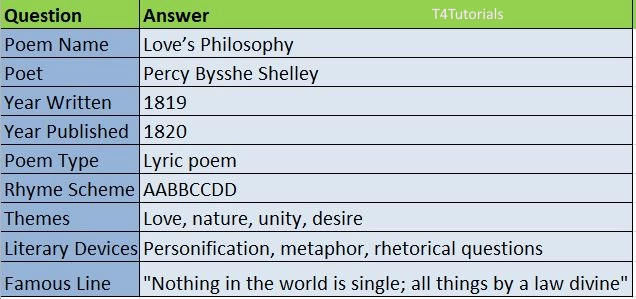Summary:
Percy Bysshe Shelley’s Love’s Philosophy is a romantic and persuasive poem that expresses the poet’s longing for unity with his beloved. The poem presents a philosophical argument that everything in nature is connected—rivers mix with the ocean, mountains rise into the sky, and the earth and heaven are in harmony. The poet uses these natural interactions as a metaphor for human relationships, arguing that love should also follow this universal law of unity. In the first stanza, Shelley describes how elements of nature—rivers, fountains, and waves—blend together. He suggests that human beings should also follow this pattern of unity. In the second stanza, he continues his argument by describing how the sun, moon, and flowers interact with one another, reinforcing the idea that love is a natural and necessary connection. Throughout the poem, Shelley uses rhetorical questions to persuade his beloved to reciprocate his love. He suggests that if nature itself follows the law of attraction and unity, then human beings should not resist love. The poem ends with a question that expresses the poet’s frustration—if everything in the universe is interconnected, why should he be denied the love he seeks? The poem’s tone is gentle and persuasive, making it a beautifully crafted argument for love as a natural force.
10
Score: 0
Attempted: 0/10
Subscribe
| Question | Answer |
| Poem Name | Love’s Philosophy |
| Poet | Percy Bysshe Shelley |
| Year Written | 1819 |
| Year Published | 1820 |
| Poem Type | Lyric poem |
| Rhyme Scheme | AABBCCDD |
| Themes | Love, nature, unity, desire |
| Literary Devices | Personification, metaphor, rhetorical questions |
| Famous Line | “Nothing in the world is single; all things by a law divine” |